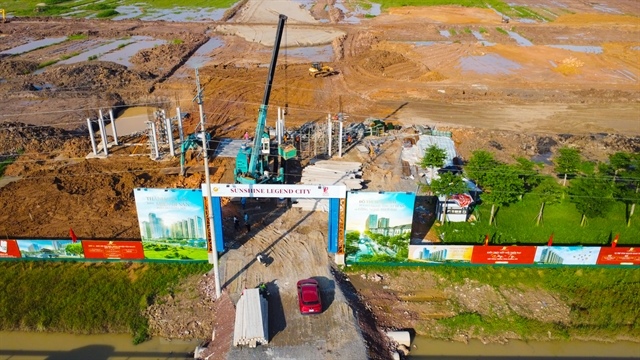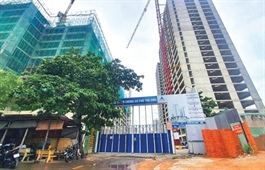Property transfer tax deemed crucial to curb speculation
Property transfer tax deemed crucial to curb speculation
As housing prices in Vietnam continue to soar, calls are being made for a regulatory filter to steer the market towards stability and real value rather than speculation.
The Ministry of Finance (MoF) is currently drafting a revised personal income tax law, which includes two proposed taxation schemes aimed at speculative activities and short-term property flipping with two options - either imposing a 20 per cent capital gains tax on net profits after deducting eligible expenses, or applying a progressive tax based on holding period, starting at 10 per cent of the transfer price if the property is sold within two years.
According to MoF calculations, compared to the current flat tax rate of 2 per cent on the transfer price, a 20 per cent tax on actual income would yield a roughly equivalent tax burden.
In certain cases, where the price difference between purchase and sale is small, or if the transaction generates a loss, taxpayers could even benefit from the new method, as it better reflects actual profits.
In its Q2/2025 report on the housing and real estate market, the Ministry of Construction (MoC) supported the MoF’s proposed policy of taxing the price differential in successive real estate transactions, calling it “a necessary move” to curb speculation and price manipulation.
Additionally, the MoC proposed that the MoF study a tax policy targeting the price gap between state-calculated land-use fees and the actual selling price in real estate projects. Taxation on idle or unused properties was also recommended.
According to Deputy Minister of Finance Cao Anh Tuan, a 20 per cent personal income tax on real estate transfer gains must be phased in gradually, aligned with reforms in land and housing policies, and contingent on the readiness of data infrastructure and IT systems related to real estate registration and transactions. These systems would enable tax authorities to accurately assess taxable income and enforce the law effectively.
Assoc. Prof. Dr. Phan Huu Nghi, deputy director of the Institute of Banking and Finance at the National Economics University, advocated for a mechanism akin to corporate income tax, such as levying taxes on net profits after deducting legitimate expenses.
“To implement this, we must integrate existing sales price databases and enforce strict penalties for false price declarations. This approach will make the real estate market more transparent and help eliminate dual pricing and speculative behaviour,” Nghi said.
Dr. Tran Xuan Luong, deputy director of the Vietnam Real Estate Market Research Institute, warned that if the tax is implemented hastily, the 20 per cent rate could be excessive. “The MoF should consider halving the rate initially to allow people time to adjust. More importantly, before nationwide rollout, a unified data system must be established to ensure market transparency,” Luong stated.
Real estate prices in Vietnam often rise not because of supply and demand fundamentals, but because of speculation and flipping expectations. A plot of unused land can double or triple in price within months, not due to infrastructure development or productive use, but simply from being hoarded and timed for resale.
“In a market where land hoarding yields easier returns than actual business operations, real estate strays far from its true function, providing shelter or serving as a production asset,” said Manh Long, an individual investor. “This distorts the market and creates social consequences. Housing becomes a luxury, land value no longer reflects utility, and urban planning is undermined by speculative land fever.”
A well-designed tax policy could effectively reshape market behaviour by clearly distinguishing genuine end-users and long-term investors from short-term speculators. The right tax structure would promote fairer resource allocation and improved access to housing.
The purpose is not to punish multiple-homeowners or genuine investors, but to differentiate between real housing needs, long-term investment, and profit-driven arbitrage. If properly implemented, the policy could help redirect speculative capital towards value-based investments, Long added.
Beyond curbing speculation, the shift from a flat 2 per cent transfer tax to a 20 per cent tax on actual profits represents a key step towards tax equity. In practice, this method may not result in a significantly higher tax burden. In fact, for transactions with little or no profit, the new method may be more favourable for sellers.
|
Nguyen Anh Que, executive committee member Vietnam Real Estate Association
The idea behind taxing real estate is to stabilise property prices. However, Vietnam is in a growth era, targeting double-digit economic expansion, facing the risk of higher US tariffs, and rolling out massive public investment. In this context, real estate plays a vital role as a growth engine.
The government faces a dilemma: how to tax property to cool the market while still enabling the sector to drive economic growth.
I suggest taxing second and subsequent residential properties, but only on housing and residential land. For idle properties, we need a clear definition and authority to assess them. We could pilot the policy in Hanoi and Ho Chi Minh City, using a progressive tax scale based on the number or value of properties.
For capital gains based on holding periods, I propose applying progressive rates from 6 down to 2 per cent.
David Jackson, CEO, Avison Young Vietnam
The proposed 20 per cent capital gains tax should be viewed within the broader framework of reforms aimed at building a healthier, more sustainable market.
Policymakers are targeting three pillars: increasing supply where it is most needed, encouraging demand for real buyers while discouraging speculative buyers, and strengthening the legal framework.
The new tax structure reflects true transaction profits, aligns with international practices, promotes transparency and equity, and encourages long-term asset holding.
However, for this to work, we need accurate, comprehensive real estate data. In the short term, challenges may arise due to difficulty in determining cost bases and eligible deductions. But in the long term, it is a positive step towards market stability.
Experiences from countries like Singapore, the US, and Germany show that building a complete real estate database can take 10–20 years before implementing transfer taxes. Vietnam is taking similar steps to develop a national housing and property database.
The goal is to integrate information from tax authorities, land registries, notaries, and banks, ensuring seamless and accurate data collection. That is why a multi-phase roadmap is essential, starting with clear mechanisms to determine cost bases and eligible expenses, and ensuring the data is timely and complete.
Giang Huynh, director of Research Savills Ho Chi Minh City
It is essential to clearly define the objectives of the policy before analysing its impact. When comparing the current 2 per cent tax on the transfer price with the proposed 20 per cent tax on actual profit, the first objective appears to be increasing budget revenue, as the proposed tax would, in most cases, yield higher collections and more accurately reflect actual profits.
The second objective is to ensure tax fairness, where individuals with higher profits would pay higher taxes. Looking further ahead, a third objective is for the policy to serve as a market-regulating tool, helping to curb speculative real estate holdings and encourage more transparent transactions. These are positive goals that could benefit the market in the long term.
However, when assessing the feasibility and practical implementation of such a policy, significant challenges remain.
In practice, a prerequisite for applying this profit-based tax scheme is the existence of a reliable market price database that records purchase and sale prices, as well as associated costs. At present, no comprehensive data system is in place. Therefore, implementation of such policies under current conditions remains difficult.
Enforcing this policy without the necessary infrastructure would have two main consequences. Firstly, it could reduce market liquidity, slowing down transaction processes, hindering tax collection, and potentially leading to disputes or legal conflicts.
Secondly, the impact may not be direct. Higher taxes would likely push sellers to maintain their minimum profit margins by transferring the tax burden to buyers, potentially resulting in higher housing prices. This could make homeownership less accessible for genuine buyers.
Therefore, for the policy to be implemented effectively, two key factors must be addressed: infrastructure and a clear roadmap.
- 14:31 05/08/2025





























